Steam boilers were used earlier for the production of steam in trains. Later on, with the development in the construction of these boilers, these boilers are classified into different types based on the generation of steam. The steam generated should be of high pressure in order to increase efficiency. So, to generate more steam, steam boilers are classified as water tube and fire tube boilers. The water tube boiler generates more steam of high pressure whereas a fire tube boiler generates steam of low pressure. We will discuss the fire tube boiler, different types of firetube boilers, defects, and uses.
Fire Tube Boiler
In Fire Tube Boilers, hot flue gases will be flown inside the tube and these tubes are surrounded by water. These are the low-pressure boiler which cannot generate much heat compared to water tube boilers. As the production of heat is less the overall efficiency of this boiler is also low. The figure which depicts the fire tube boiler is shown below.
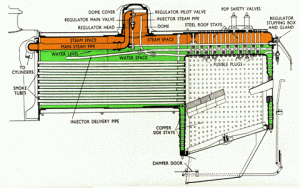
Fire-tube boiler
Different Components & Mountings Placed on the fire tube boiler
Mountings are those which are used for the functioning of the boiler and these play a critical role in the proper design of the Fire tube boiler
- Safety valve
- Feed check valve (a kind of non-return valve)
- Water level indicator
- Pressure gauge
- Steam stop valve
Pressure Gauge
The pressure gauge is mounted on the top of the shell. It indicates the amount of pressure observed inside the boiler. It is a dial-type instrument that indicates pressure in different units such as kgf/cm2 or K.pa or PSI. Now a day’s digital type instruments are also used where it senses the pressure by some transducers and sends the signal to the display unit.
Water Level Indicator
During the operation of the boiler, the operator must know the level of water. If not knowing the boiler cannot withstand the pressure and may lead to an explosion. So, a water level indicator is mounted to the shell of the water tube boiler.
Safety Valve
Water at higher pressures has a lot of energy so, safety precautions should be taken to prevent any loss. For this purpose, we install a safety valve to the boiler. Whenever the pressure is above the prescribed limit I,e withstand capability then safety valve will be opened. At-least two safety valves are to be provided.
Steam Stop Valve
A stop valve is provided to operate the steam control according to the requirement, the wet steam in the shell is sent to the superheater to reheat. The reheated steam is resent to the shell in this situation, the steam stop valve is operated to meet the requirements.
Feed Check Valve
It is used for the entry of feed water into the boiler and also used as a non-return valve to prevent the feed water from returning.
Accessories are provided to increase the efficiency of the boiler. They are
- Superheater
- Economizer
- Air pre-heater
Without mountings, boilers cannot operate but without accessories, boilers can operate. The efficiency will be low without accessories.
Types of Fire Tube Boilers
1) Cochran Boiler
It is a vertical, multi-tubular, internally fired, and naturally circulated type boiler. The shell of this type of boiler is arranged in the vertical direction that has multi tubes. These multi tubes arranged in vertical and the high pressurized flue gases will be passed through them. These tubes are surrounded by water and will be heated by the hot flue gases passed through the tubes. The combustion process takes when the hot flue gases are passed through the tubes that heat the surrounding water. The heated water beyond its temperature limits will be converted to steam that is further used for the production of electricity. This combustion process takes place is of internally fired and water circulated naturally.
Components
The boiler shell is hemispherical and consists of a furnace, firebox, Grate, combustion chamber, flue pipes, smokebox, chimney, boiler mountings, and accessories.
Construction
Shell is attached to a hemispherical head where steam is collected. The grate is provided with some spaces such that to pass air which helps in the combustion of fuel. Ash pit is placed below the grate to collect the unwanted particles. The firebox is provided above the grate where the combustion of fuel takes place and the flue gases developed will travel from the firebox to the flue tubes.
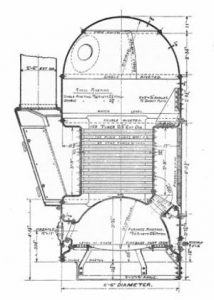
Cochran boiler
The waste material from flue gas which is not burnt is collected in the smokebox. This material is exhausted into the atmosphere through a chimney provided at the top. A water level indicator is provided at the top to check the level of water. Pressure gauge to check the pressure and an Anti-priming pipe is provided in a hemispherical shell to reheat the wet steam by super-heater. A Tap is provided at the bottom to remove the water for maintenance.
Working
The fuel can be Oil, gas or coal is burnt in the firebox placed over the grate. The flue gases generated by the combustion of coal will be sent to the flue tubes which are surrounded by water. The heat of flue gases gets transmitted to the water surrounded. The heated water gets evaporated and converted into steam which is collected in the hemispherical shell.
Applications
- Cochran Boiler is used in small industries.
2) Locomotive boiler
It is a horizontal, multi-tubular, internally fired, and naturally circulated type boiler. This type of boiler is mounted horizontally in direction and has multi tubes. In this type, the combustion takes place internally and water will be circulated naturally. It operates similar to that of a Cochran boiler but the construction is different. These individual types of boilers have their own advantages and applications. As the operation is internally fired and uses natural circulation, it is considered to be a fire tube boiler.
Components
Boiler shell is with a steam dome, furnace, firebox, Grate, combustion chamber, flue pipes, smokebox, chimney, boiler mountings, and accessories.
Construction
Shell is attached to a steam head where steam is collected. Grate made of cast Iron is provided with some spaces such that to pass air which helps in the combustion of fuel. Ash pit is placed below the grate to collect the unwanted particles. The firebox is provided above the grate where the combustion of fuel takes place and the flue gases developed will travel from the firebox to the flue tubes. Locomotive Boiler is shown in the figure below.
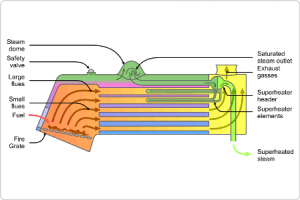
Locomotive Fire Tube Boiler
The waste material from flue gas which is not burnt is collected in the smokebox. This material is exhausted into the atmosphere through a chimney provided at the top. A water level indicator is provided at the top to check the level of water. Pressure gauge to check the pressure and an Anti-priming pipe is provided in a hemispherical shell to reheat the wet steam by super-heater. It uses an artificial draught fan which sends the unwanted flue gases into the atmosphere.
Working
The fuel can be oil, gas or coal is burnt in the firebox placed over the grate. The flue gases generated by the combustion of coal will be sent to the flue tubes which are surrounded by water. The working of the Locomotive fire tube boiler is shown in the figure below.
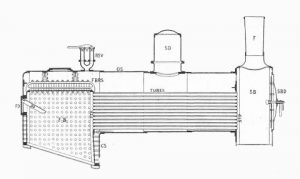
Locomotive boiler
The heat of flue gases gets transmitted to the water surrounded. The heated water gets evaporated and converted into steam which is collected in the hemispherical shell.
Disadvantages
- It requires more space.
- Efficiency is less.
- Steam Generation is low.
Advantages
- It is a portable boiler.
- Low operating cost.
- The maintenance cost is low.
Applications
- It is used in small rated plants
3) Lancashire Boiler
Construction
Lancashire Boiler is enclosed in brickwork. It consists of fire tubes surrounded by water and the fire tubes are conical towards the rear end. A brick arch is placed after the furnace in order to increase the flow of hot gases. Dampers are provided at the end of the fire tubes for proper passage of air. Feedwater valve, water level indicator, steam check valve, and a manhole are provided on the top of the shell.
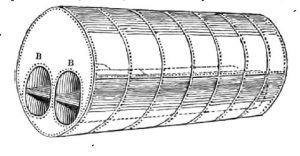
Lancashire boiler
Working
The fuel heated produces hot flue gases which further heats the water surrounded by the fire tubes. The hot flue gases flow inside the firetubes heats the surrounded water. The heated water is converted to steam at high temperatures. The produced steam travels to the anti-priming pipe where the wet steam and hot steam is separated. the wet steam is further superheated and the dry steam is fed to the steam stop valve. The generated steam is utilized to drive a turbine which is used for the generation of Electricity. The end view of the Lancashire boiler is depicted below.
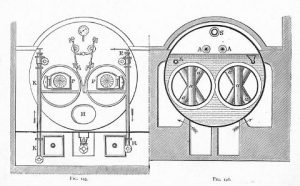
Lancashire boiler end view
Advantages
- It is more reliable
- Less maintenance
- Less cleaning effort
- The good thermal efficiency of about 80%.
- Easy to operate.
Disadvantages
- Requires more space
- Takes more time to generate steam
- It cannot generate high-pressure steam.
Know more about Steam Boiler.
Thus, in this article, we have learned what is a fire tube boiler, different mountings, and accessories used for its operation, different types of fire tube boilers, advantages, and disadvantages. Here is a question for the readers, Explain the contrast between a fire tube boiler and a water tube boiler.